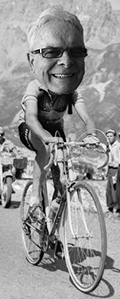Creating the perfect fork blade
 Mon, May 18, 2020
Mon, May 18, 2020  When a fork blade comes from the tube manufacturer’s factory, it is straight, the framebuilder bends it to a curve that suits his requirements.
When a fork blade comes from the tube manufacturer’s factory, it is straight, the framebuilder bends it to a curve that suits his requirements.
An un-raked road fork blade is oval at the top. The oval section runs parallel for about a third of its length.
Then the cross section becomes round and starts to taper gradually to its smallest diameter section at the bottom end.
The fork blade is bent cold on a curved form that is sometimes made from hard wood. I used one I made myself from two heavy-duty steel fork blades, bent in the desired curve, and brazed together side by side. This made a natural groove between the two blades where the blade would sit as I was bending.
I would slip a short piece of tube over the thin end of the form and the blade I was bending. This acted as a collar to hold it in place. Then I'd start bending, first by pushing down by hand. The thin end of the blade bends easily, and I would finish off by squeezing it in a vise.
Bicycle tubing is hardened, and it will spring back after bending. Because of this, the form needs to be a greater curve than the finished fork blade will be.
A fork blade is several inches longer than it needs to be. The framebuilder chooses where he will put the bend, and where he will cut to length. For example, if I were making a criterium frame and wanted a very stiff fork, I would cut from the bottom, thin end. The desired fork rake (Offset.) also has to be considered. The amount of bend, and where the tube is cut will determine this.
If I were building a touring frame, and wanted a flexible fork for a more comfortable ride and more offset, I would cut from the top end and leave the blade thin at the bottom end. The framebuilder creates the perfect fork blade, by selecting the best place to bend the blade, the amount of bend and by choosing how much to cut from either end.
It is rather like a furniture maker choosing where to cut from a piece of wood to achieve the best end product. Once I arrived at the perfect fork blade, it was then an easy matter to repeat the process again and again. On this John Howard frame below, for example.

One exception to this process was the Reynolds 753 fork blades. 753 was heat treated to a degree that the material could not be bent after. These were bent at the factory, then heat treated, and the framebuilder then cut the blade to the required length.
The cut alone determined the fork rake, and I had no control over the placement or shape of bend. You will notice on this 753 Fuso Lux frame (Pictured below.) that the fork bend is a different shape than the ones bent by me.
On the red 753 frame there appears to be more rake, but this is not the case, the amount of offset is the same. The 753 blade has a tighter bend near the bottom, whereas the one’s I bent by hand, have a gradual curve that begins about half way.

Chainstays and seatstays are also tapered and the same selective cutting to length is employed. In this case, where the cut is made depends a great deal on the size of frame and its end use.
The perfect fork blade is stiff enough to allow precise handling, but with some flex to absorb road shocks. It also looks pleasing to the eye. I have a theory that when something is designed correctly from a functional standpoint, it has a natural aesthetic beauty. This is true of a boat, a bridge, a building, and even a bicycle frame.
The modern trend of building straight forks of course saves the framebuilder a great deal of time and effort. If this look has become acceptable, why should today’s builder go through all the time consuming process I have described here?
The straight blade is angled forward so the same fork rake or offset is achieved and handling would be the same. I can’t comment on the shock absorption qualities because I have never built a frame with a straight fork.
In my view, a great deal is lost aesthetically, so where does that leave my theory about function being linked to aesthetics? On the other hand, is it simply that beauty is in the eye of the beholder?




























